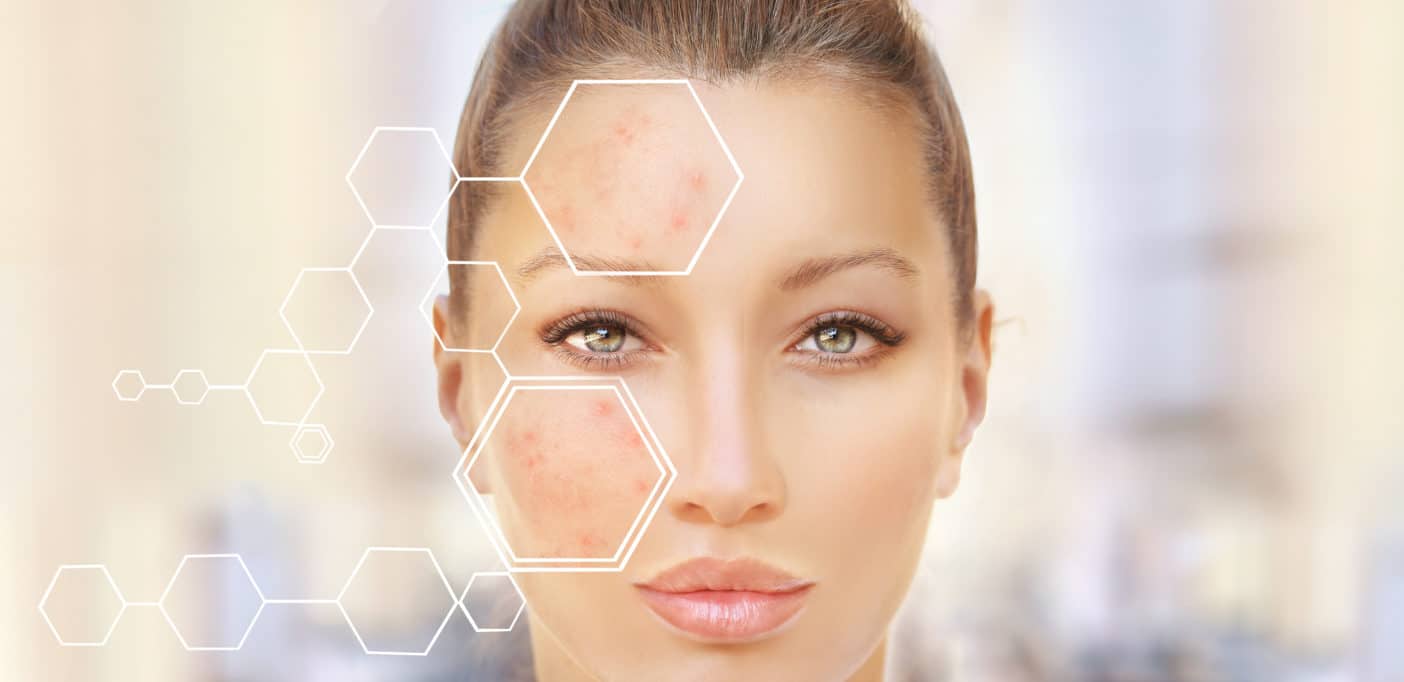Skin Microbiome

The skin microbiome and its influence by cosmetic ingredients is of increasing interest to the cosmetics industry. The use of microorganism-based ingredients to promote healthy skin flora is becoming increasingly important. The balance of microorganisms living on the skin is positively influenced by probiotic lysates. The skin microbiome plays a fundamental role in skin health and the two are intimately linked.
Skin flora care is an emerging topic in cosmetics. An increasing number of brands are launching products that claim to have a positive effect on the skin flora and contain ingredients of microbiological origin. Some brands even advertise the presence of live bacteria that are beneficial to the microbiome. Both raw material and active ingredient manufacturers are following this trend by offering “probiotic” and “prebiotic” ingredients.
Does microbiome skincare make sense?
When considering the use of probiotic lysates in skincare, the answer is clearly in the affirmative. The success of these lysates in the industry emphasises their cosmetic relevance and their benefits for the skin are confirmed by an increasing number of scientific studies. Consumer satisfaction with probiotic bacterial lysates therefore appears to be based on sound science.
What is the skin microbiome?
The skin flora is the complex ecosystem of microorganisms that colonise the outer surface of our body. To understand the success of using probiotic lysates and other ingredients in skin care, we need to recognise the importance of this microbiome. Our bodies, both internally and externally, are colonised by a multitude of microorganisms, which may lead us to speak of ‘Homo microbiens’ rather than ‘Homo sapiens’. For every human cell, there are between one and ten microorganisms that either live on us or in symbiosis with us. Of these, only one per cent are pathogenic, while 99 per cent support our body or live in harmony with it. The skin benefits from its microbiome and the microbiome benefits from the skin. This interdependence is crucial to our survival and represents a true symbiosis in which both sides depend on each other.
Hundreds of different types of microorganisms exist on the skin, illustrating the enormous diversity of the skin flora. This diversity is reflected in the different skin zones: facial skin is rich in sebaceous glands and therefore oily, while the skin on the arms tends to be drier. The armpits, on the other hand, provide a moist and warm environment. These differences create different habitats for the microbiome, each with a specific composition. Using terrestrial climates as an analogy, the skin on the forearm could be compared to a desert landscape, the scalp to a cool forest and the armpit to a tropical rainforest.
Influences on the skin flora
The skin environment determines which microorganisms can live in which places. In addition to external and internal influences that lead to different skin conditions such as dryness, moisture, cold or heat, the skin itself also plays a decisive role. The amount of sebum produced by the skin is an important factor, as some microorganisms favour sebum, while others do not react to it. In addition, the substances produced during the differentiation processes in the epidermis have a significant influence on the skin environment. Cosmetic products can reduce sebum production and influence epidermal differentiation, which may have a positive effect on the skin environment.
The importance of proper differentiation in the epidermis becomes obvious when this process is disturbed, as is the case in some skin diseases. In cases of atopic dermatitis, for example, the pathogenic bacterium Staphylococcus aureus is present in increased numbers, which contributes significantly to the pathophysiology of the disease. Other influences such as ageing, lifestyle, diet and skin care are also discussed in the scientific literature. These aspects are particularly interesting in the context of developing cosmetic products. It would be conceivable to develop an “anti-ageing” skin care product that rejuvenates the skin environment.
Recent literature also mentions the “temporal stability” of the skin microbiome, which means that it is surprisingly stable over a longer period of time despite the influences mentioned. The question cosmetic scientists are asking themselves is: How can we stabilise or improve the skin environment in the context of cosmetics? To answer this question, we need to take a closer look at the symbiosis between a healthy microbiome and healthy skin.
The skincare market is seeing growing consumer interest in “healthy skin”. Consumers are placing more emphasis on their skin looking and feeling healthy, as healthy-looking skin is considered attractive. This positive change in attitude probably also explains why the microbiome is becoming increasingly important in the cosmetics industry.
“Healthy” skin has a “healthy” microbiome
What does healthy skin mean? The answer to this question lies in the epidermis. The top layer of the skin is highly dynamic and intelligent. Hundreds of different molecules (proteins, enzymes, lipids, etc.) are formed in the epidermis. They keep the stratum corneum and the skin’s immune defence strong and healthy. The stratum corneum is the barrier between the body and the external environment. Its condition is crucial for many cosmetic aspects of the skin: healthy appearance (rosy, even, attractive, etc.), pleasant skin feel (soft, smooth, elastic, etc.). The microbiome is located on and in the stratum corneum. In the course of the differentiation processes in the epidermis, substances are formed that are necessary for the formation of the skin flora. These include molecules that regulate the pH value (a pH value of approx. 5 on the skin surface is ideal for a “healthy” microbiome) and antimicrobial peptides (kill pathogenic microbes). A properly (“healthy”) functioning skin (epidermis) is able to produce all the components required for a “healthy” microbiome. The microorganisms that live on the skin interact with the skin cells to maintain/create an environment that is favourable to them. A “healthy” microbiome is good for “healthy” skin and vice versa. We live in homeostasis with each other; that is the essence of a symbiotic relationship. Which of the parties involved is leading the relationship? It is the skin. When the differentiation in the epidermis is functioning properly (i.e. when the skin is healthy), its microbiome is also healthy. In the skin diseases atopic dermatitis, rosacea and psoriasis, the differentiation process in the epidermis is disturbed. This results in changes in the skin flora. All three skin diseases are associated with changes in the microbiome. S. aureus colonises the skin in atopic dermatitis, for example, and is part of the pathophysiology. (S. aureus triggers inflammation in the skin. The increase in S. aureus is associated with flare-ups in atopic dermatitis). S. aureus requires a pH value of approx. 7; due to the errors in the differentiation processes in the epidermis of atopic skin, the pH value is 7.
Formulations for the skin microbiome
When formulating a cosmetic product that is also ideal for the skin microbiome, many unavoidable influences to which the microbiome is exposed must be taken into account. For example, individual skin care behaviour, the presence of antimicrobial ingredients (preservatives) in cosmetic products or the pH value of cosmetic products. The environment in which we live (country or city) also influences the composition of the skin microbiome. Microorganisms are constantly being lost from the skin, be it through shaving, rubbing clothes or, above all, the shedding of dead skin cells. Hundreds of millions of dead cells are shed from the skin every day, along with billions of microorganisms. Despite the constant removal or killing of microorganisms from the skin’s surface, the composition of the microbiome remains remarkably stable. As scientific studies confirm, even antibiotics and antiseptics have only a limited effect on its stability. Although such substances kill microorganisms, they recover quickly. The skin microbiome rebuilds itself within a surprisingly short time, as does the influence of other factors mentioned.
The skin microbiome renews itself, just like the skin
In order to develop cosmetic products that are beneficial for the skin microbiome, we need to understand the basics of the processes described above. Why is the microbiome so robust despite all these unavoidable influences? Why does it recover so quickly, even after exposure to antiseptics? A scientific finding provides the answer: the microorganisms not only colonise the skin surface, but also live inside the skin. They colonise the stratum corneum, especially the upper half, the stratum disjunctum. Here the corneodesmosomes are dissolved between the dead horny cells, the corneocytes. The skin “opens up” and allows the microbes to colonise the stratum disjunctum between the corneocytes. The epidermis renews itself continuously and its differentiation processes are in equilibrium with the formation of new cells (proliferation) in the lowest layer of the epidermis. From their formation site in the lowest layer to the skin surface, the cells go through a process of about four weeks. As soon as they reach the skin surface and are present as dead horny cells/corneocytes, they are shed from the skin surface as scales. The microorganisms in the stratum disjunctum move to the skin surface together with the corneocytes and are also shed or killed. Like the epidermis, the microbiome is therefore also continuously renewed through the processes of death and shedding, whereby the actual “source” of the skin microbiome lies in the stratum corneum, under the stratum disjunctum.
It is therefore not surprising that it is not primarily a question of how we can influence the microbiome on the skin surface. It makes little sense to influence microorganisms that are rejected, rubbed off or killed, for example with prebiotic substances. It is more efficient and sustainable to concentrate on the “origin” in the stratum corneum, as this is the actual “source” of the microbiome. Given the close link between the skin and the microbiome, which form a physical unit, it is not surprising that the differentiation processes in the epidermis are so important for the skin microbiome. If these processes function properly, they guarantee the quality and health of the microbiome at its “origin”. Accordingly, measures that start on the surface also remain on the surface with their results.
Our conclusion
It makes sense to influence the skin flora. Science has only recently begun to address this topic. Many questions are still unanswered. One promising approach appears to be the optimisation of differentiation processes in the epidermis. Only if they function well can the microbiome remain healthy in the long term. Many cosmetically relevant skin conditions are characterised by disturbed differentiation processes in the epidermis. Please contact us if you would like us to develop such a product for your brand.
Sources:
Publikation 15.6.2022 Haut-Mikrobiom und Kosmetik – eine Bestandsaufnahme; Deutsche Gesellschaft für wissenschaftliche und angewandte Kosmetik e.V. (DGK) www.sgk-ev.de/wp-content/uploads/2022/06/Microbiom
Skin Barrier Function and the Microbiome.; Int J Mol Sci. 2022 Oct 28;23(21):13071.
Microbiome and Probiotics in Acne Vulgaris-A Narrative Review.; Life (Basel). 2022 Mar 15;12(3):422.
Probiotics in Cosmetic and Personal Care Products: Trends and Challenges.; Molecules. 2021 Feb 26;26(5):1249.
